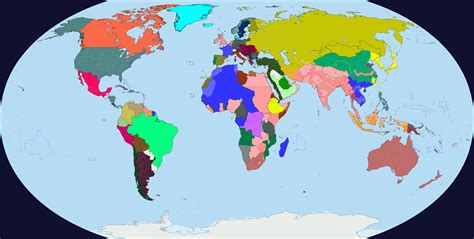Introduction:
Before the outbreak of World War I in 1914, the world map presented a remarkably different geopolitical landscape. The European powers dominated global affairs, while Asia, Africa, and South America remained largely colonized. This article delves into the intricate map of the world prior to the Great War, shedding light on the territorial boundaries, political alliances, and emerging tensions that shaped the global stage.

Territorial Boundaries:
Europe was characterized by complex borders and intricate national identities. The German Empire, with its industrial might and growing ambitions, occupied a central position in Central Europe. To the east, the vast Russian Empire stretched across vast territories, encompassing a diverse array of ethnic and linguistic groups.
In the Balkans, a patchwork of small nations, including Serbia, Bulgaria, Romania, and Greece, competed for influence amidst shifting political alliances. The Ottoman Empire, once a formidable power, was in decline, holding onto parts of Europe, the Middle East, and North Africa.
Colonial Empires:
By the early 20th century, European powers had established extensive colonial empires across the globe. The British Empire, with its far-flung dominions and dependencies, was the largest and most powerful. France possessed significant territories in North and West Africa, as well as Indochina (present-day Vietnam, Cambodia, and Laos).
Germany, a latecomer to the colonial race, had acquired possessions in East Africa, Southwest Africa (present-day Namibia), and the Pacific islands. Italy, with its focus on the Mediterranean, had established colonies in Libya and Eritrea.
Political Alliances:
In the years leading up to WWI, two major alliances emerged in Europe. The Triple Alliance, formed in 1882, comprised Germany, Austria-Hungary, and Italy. The Triple Entente, established in 1907, brought together France, Russia, and Great Britain.
These alliances were based on shared strategic interests and mutual fears. The Triple Alliance aimed to maintain the status quo in Europe and contain Russia’s expansionism. The Triple Entente sought to counter Germany’s growing influence and protect French and Russian interests.
Emerging Tensions:
Beneath the facade of relative stability, tensions were escalating between the European powers. Germany’s economic and military strength threatened the established order, while Austria-Hungary’s precarious position in the Balkans became a focal point of conflict.
Russia’s ambitions in the Balkans and the Ottoman Empire set it on a collision course with Germany and its allies. Meanwhile, Great Britain’s naval superiority and global interests clashed with Germany’s desire for overseas expansion.
Table 1: Major European Powers Pre-WWI
| Country | Area (sq. km) | Population (1910 est.) |
|---|---|---|
| Germany | 540,858 | 67,140,000 |
| Russia | 17,075,400 | 174,122,000 |
| France | 547,030 | 41,785,000 |
| Austria-Hungary | 621,500 | 51,333,000 |
| Great Britain | 312,685 | 45,375,000 |
Table 2: Colonial Possessions Pre-WWI
| Empire | Territories |
|---|---|
| British Empire | India, Canada, Australia, New Zealand, South Africa, Egypt, Cyprus, Sudan, Kenya, Uganda, Nigeria, Sierra Leone, Gold Coast (Ghana), Zambia, Zimbabwe, Malawi |
| French Empire | Algeria, Tunisia, Morocco, Madagascar, Indochina (Vietnam, Cambodia, Laos), Congo, Senegal, Benin, Niger |
| German Empire | German East Africa (Tanzania), Southwest Africa (Namibia), Togoland (Togo), Kamerun (Cameroon), New Guinea |
| Italian Empire | Libya, Eritrea, Somalia |
Table 3: Political Alliances Pre-WWI
| Alliance | Members |
|---|---|
| Triple Alliance | Germany, Austria-Hungary, Italy |
| Triple Entente | France, Russia, Great Britain |
Table 4: Emerging Tensions Pre-WWI
| Conflict Zone | Major Issue |
|---|---|
| Balkans | Serbian nationalism vs. Austro-Hungarian dominance |
| Russia-Germany | Russian expansionism vs. German containment |
| Great Britain-Germany | Naval rivalry and colonial competition |
Conclusion:
The world map pre-WWI reflected a complex tapestry of power, ambition, and conflict. European dominance had reached its peak, but cracks were beginning to appear. Colonial empires stretched across continents, but resentment and resistance were stirring. The alliances and tensions that shaped this era would ultimately culminate in the outbreak of a global war that would forever alter the global landscape.
FAQs:
1. What was the largest empire in the world pre-WWI?
The British Empire was the largest, with territories spread across all continents.
2. What was the primary cause of WWI?
A complex web of factors, including nationalism, militarism, imperialism, and alliance structures, contributed to the outbreak of the war.
3. Which country was known as the “Sick Man of Europe”?
The Ottoman Empire was referred to as the “Sick Man of Europe” due to its declining power and economic instability.
4. What was the significance of the Balkan region pre-WWI?
The Balkans was a hotspot of ethnic and political tensions, and Serbian nationalism played a major role in triggering WWI.
5. How did colonialism impact the global landscape?
Colonialism led to the exploitation of resources, the spread of Western ideas, and the rise of nationalist movements in colonized territories.
6. How did the European alliances contribute to the outbreak of WWI?
The complex alliances between European powers created a climate of mistrust and increased the risk of conflict.
7. What were the long-term consequences of WWI?
WWI resulted in the collapse of empires, the rise of new nation-states, and significant economic and social changes worldwide.
8. How can we learn from the lessons of WWI to prevent future conflicts?
Understanding the complexities of WWI can help identify patterns and develop strategies to promote peace and prevent future wars.
